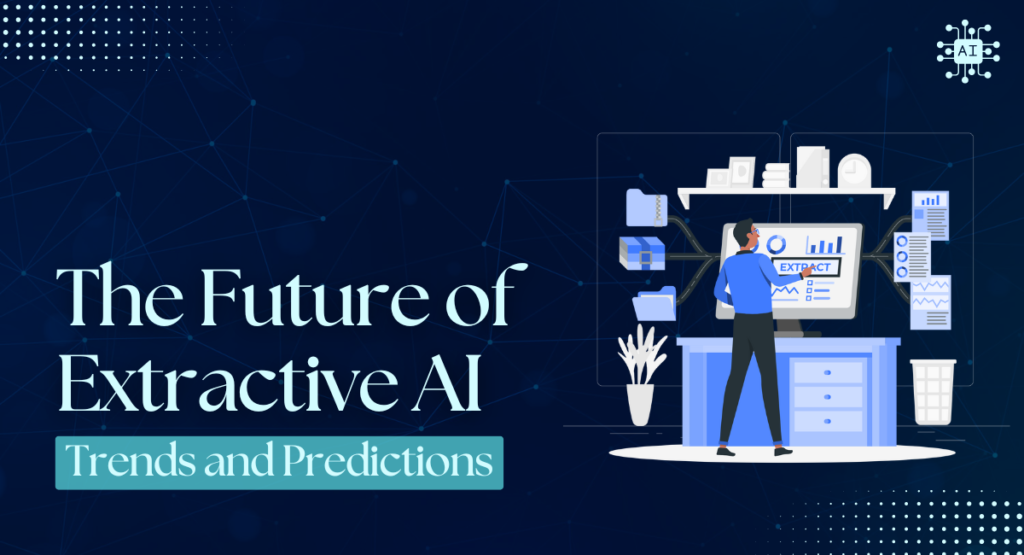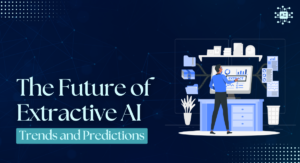Extractive AI is growing fast and has new business opportunities in extracting data from unstructured and semi-structured sources. Such changes alter how organizations apply this technology to enhance operations, decision-making, and business growth.
With the continued development of technology, companies using data-driven decision-making need to continually keep themselves updated with regard to the trends.
Here are some key Trends and Predictions Shaping the Future of Extractive AI.
Key Trends in Extractive AI
As we move forward, the Future of Extractive AI will follow several important trends that will impact businesses and industries. These trends are essential for companies looking to stay ahead by using data more effectively.
1. Increased Use of Natural Language Processing (NLP)
Natural Language Processing (NLP) is becoming crucial in extractive AI. It helps AI systems understand context, sentiment, and nuances in language, going beyond simple keyword extraction.
- Why it matters: Companies dealing with large amounts of unstructured data, like customer service logs or legal contracts, benefit from AI systems that analyze context and sentiment. This makes the data more valuable and actionable.
- Business impact: NLP helps businesses analyze customer feedback more effectively, improve contract management, and quickly extract actionable insights.
2. Automation Integration and Workflow Optimization.
AI systems are increasingly integrated into automated workflows, streamlining business processes. These systems remove repetitive tasks such as processing forms, invoices, or receipts.
- Why it matters: Automation allows companies to handle large volumes of documents faster and with fewer errors. AI can now process thousands of documents in minutes, saving significant time and resources.
- Business impact: Automation helps businesses scale their operations without adding extra costs. It also allows teams to focus on more strategic work instead of manual data extraction.
3. Real-Time Data Extraction Capabilities
As businesses become more data-driven, the need for real-time data extraction is growing. Whether it’s stock market data, customer feedback, or live sales reports, companies are demanding instant access to actionable insights.
- Why it matters: Real-time data extraction helps businesses respond quickly to changes in the market, improving agility and decision-making. With AI capable of extracting data as it comes in, companies can avoid delays that could affect strategic initiatives or customer satisfaction.
- Business impact: Industries like finance, e-commerce, and logistics particularly benefit from real-time extraction, as they rely on up-to-the-minute data to make critical decisions.
4. Handling of Semi-Structured Data
AI systems are becoming better at handling semi-structured data—data that doesn’t fit neatly into traditional formats but still contains some identifiable patterns. Examples include emails, invoices, and social media content, all of which businesses are increasingly reliant upon.
- Why it matters: Traditional data extraction tools often struggle with semi-structured data, leading to inaccuracies or requiring extensive manual adjustments. However, AI systems are now better equipped to identify and categorize data fields, making it easier to extract meaningful information.
- Business impact: More accurate handling of semi-structured data improves operational efficiency and reduces the time spent on data cleaning or formatting, allowing for quicker decision-making.
5. Advancements in Computer Vision for Document Recognition
Computer vision has been improving rapidly and is now an essential tool in extractive AI. By using machine learning to “see” and interpret documents, computer vision allows AI to extract data from a wide range of formats, including PDFs, scanned images, and handwritten notes.
- Why it matters: Many documents, especially older ones or those in complex formats, require visual recognition capabilities to extract data effectively. AI-powered computer vision enables organizations to digitize and analyze previously inaccessible documents.
- Business impact: Industries like healthcare and law, where large amounts of paper-based records are still in use, can now digitize and process documents faster, making critical information more accessible.
Understanding and taking advantage of such trends will make it easier for businesses to remain ahead of the competition. Interactive visuals, tables, and other engagement elements can increase reader interaction and time spent on your content by many folds.
Predictions for Extractive AI in 2024 and Beyond
As extractive AI continues to mature, its applications will expand, creating new opportunities and challenges for businesses. Below are key predictions that outline how this technology will evolve in the coming years, reshaping industries and enabling greater data-driven decision-making.
1. Wider Industry Adoption
While industries such as finance, healthcare, and legal services have been early adopters of extractive AI, other sectors are beginning to explore its advantages.
We predict that more industries—particularly retail, supply chain management, and human resources—will integrate extractive AI into their daily operations.
- Retail: Extractive AI will be used for analyzing consumer data, enabling companies to better understand purchasing behaviors, preferences, and trends. For example, AI can extract data from online reviews, social media interactions, and customer surveys, helping retailers personalize their offerings and improve customer satisfaction.
- Supply Chain Management: Companies can use extractive AI to automatically pull data from shipping documents, invoices, and contracts, streamlining logistics and improving transparency. In a global supply chain, this technology will enable real-time tracking of shipments, ensuring that all stakeholders have access to the most up-to-date information.
- Human Resources: AI will simplify hiring and employee management processes. For instance, systems can extract key details from resumes, performance reviews, and feedback forms, helping HR teams make more informed decisions and identify top talent faster.
Business Impact: The expanding adoption of extractive AI across industries will democratize access to data-driven tools. As more companies use these solutions, operational efficiency will increase, driving innovation and reducing costs across the board.
2. Better Handling of Semi-Structured Data
Semi-structured data, such as emails, forms, and documents with inconsistent formatting, presents a significant challenge for traditional data extraction systems.
Extractive AI will be more adept at processing semi-structured data, reducing errors and enhancing accuracy.
- Email Analysis: AI will be able to extract relevant data from email threads, identifying key action points and automating responses based on predefined criteria. This will save time for teams that need to sift through hundreds of emails daily to prioritize tasks.
- Forms and Invoices: As extractive AI improves, it will more accurately identify fields in semi-structured documents like invoices and forms, reducing the need for human review. Businesses will be able to process invoices, tax forms, or compliance documents faster and with fewer errors.
Business Impact: Improved handling of semi-structured data will allow businesses to access a broader range of information, driving more accurate analytics and decision-making. As AI systems learn to handle these complex formats, they will enable faster and more cost-effective operations across various departments, from finance to customer service.
3. Cloud Integration and Scalability
Cloud-based AI solutions are becoming the norm, nearly all major extractive AI platforms will offer full cloud integration. This shift allows businesses to scale their data extraction capabilities without investing heavily in physical infrastructure.
- Flexible Scalability: Cloud-based AI will enable businesses to scale their data extraction operations seamlessly. Whether a small business with modest data processing needs or a large enterprise with millions of documents, the cloud ensures that extractive AI can be customized to fit those requirements.
- Enhanced Collaboration: Cloud integration also facilitates better collaboration between teams, especially for globally distributed organizations. With all data extraction processes running in the cloud, teams across different regions can access and analyze information in real time.
- Cost-Effective: Moving extractive AI to the cloud reduces the overhead associated with on-premise servers and maintenance. Subscription-based pricing models will make these advanced tools accessible to businesses of all sizes.
Business Impact: Cloud-based extractive AI solutions will help businesses scale their data extraction capabilities rapidly and cost-effectively. This transition will enable companies to handle fluctuating data volumes without the burden of hardware limitations or downtime, making it a key driver of future business growth.
4. More Accessible AI for Small and Medium-Sized Enterprises (SMEs)
As extractive AI becomes more sophisticated, it will also become more accessible to SMEs. Historically, advanced AI systems have been costly and difficult to implement for smaller businesses.
We expect a significant shift in this area, with AI solutions tailored to SMEs that require minimal technical expertise to deploy.
- Plug-and-Play Solutions: Many extractive AI vendors are developing user-friendly, plug-and-play solutions that can be integrated directly into existing business workflows. This will eliminate the need for SMEs to invest in specialized IT teams or consultants to manage their AI systems.
- Affordable Pricing Models: Subscription-based and tiered pricing models will make extractive AI affordable for smaller businesses. This will allow SMEs to leverage powerful data extraction tools without incurring the high costs traditionally associated with AI.
- No-Code and Low-Code Platforms: The rise of no-code and low-code platforms will further democratize access to AI tools. These platforms allow non-technical users to customize data extraction workflows through drag-and-drop interfaces, making it easier for businesses to automate without hiring software developers.
Business Impact: By making extractive AI more accessible to SMEs, these companies will gain the ability to automate key processes, reduce overhead, and compete with larger enterprises. This democratization of AI technology will fuel innovation and increase productivity in sectors that have previously been underserved by advanced data extraction tools.
5. Focus on AI Ethics, Transparency, and Data Privacy
As AI becomes more integrated into business operations, ethical considerations will become increasingly important.
Extractive AI platforms will need to ensure transparency in how they handle data, particularly in sectors that deal with sensitive information.
- AI Explainability: Businesses will demand more transparency from AI systems, requiring them to explain how specific data was extracted and why certain decisions were made. This trend, known as “explainable AI,” will ensure that businesses can trust the outputs of their AI systems and make them more accountable.
- Data Privacy Regulations: With strict regulations like GDPR (General Data Protection Regulation) and CCPA (California Consumer Privacy Act) already in place, AI systems will need to adhere to even more stringent data privacy standards in the future. Companies that fail to comply with these regulations risk severe penalties.
- Bias and Fairness in AI: As extractive AI becomes more prevalent in decision-making processes, ensuring that AI models remain unbiased will be crucial. Businesses will look for AI systems that are fair and impartial, particularly in sectors like hiring, financial services, and law.
Business Impact: Companies that adopt AI systems with a focus on ethics and transparency will earn greater trust from their customers and stakeholders. By adhering to data privacy regulations and ensuring fairness, businesses can mitigate risks associated with AI adoption, while leveraging the technology for better decision-making.
Conclusion
The future of extractive AI is rich with possibilities, from real-time processing and multi-format capabilities to sustainability and privacy compliance.
As trends evolve, businesses must stay informed and adopt the right tools to remain competitive. The advancements in extractive AI promise a new era of data processing, one that’s more efficient, secure, and user-friendly.
FAQs for the Future of Extractive AI
What industries will benefit most from extractive AI in the future?
Industries like retail, supply chain, healthcare, and HR will benefit significantly from extractive AI by automating data extraction, reducing manual work, and enabling faster, data-driven decisions.
How will cloud-based extractive AI impact businesses?
Cloud-based AI allows businesses to scale data extraction without high infrastructure costs, offering flexibility and accessibility, especially for small and medium-sized enterprises.
Will extractive AI replace jobs?
No, extractive AI is more likely to augment human roles by handling routine tasks, allowing employees to focus on higher-level decision-making and strategy, improving overall productivity.
What challenges does extractive AI face in the future?
Key challenges include ensuring data privacy compliance, addressing AI bias, and improving AI transparency so businesses can trust and understand how AI makes decisions.


